Happy May to all! It seems warm for May, but the basil is happy! Basil loves heat, and grows like crazy. Most of our culinary basil is genetically prompted to bloom, attract pollinators, and produce seeds when the temperature is warm. As the seed matures and falls, the plant’s “job” is done and it will wither and die. But take heart, there is still more pesto to come!
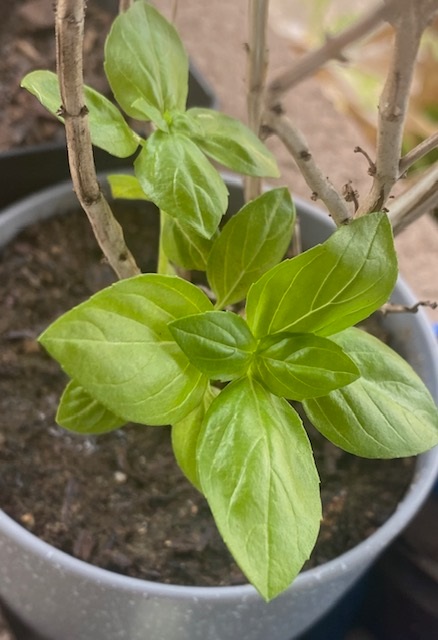
One of the connections between gardeners and plants is the timing and the distribution of seeds. As long as it is warm weather, gardeners can cut the basil blooms (dead-head) off the plant, so that it will keep producing leaves and then new blooms. That means summer-long pesto.
My favorite pesto recipe comes from Southern Herb Growing, a book written by mother and daughter, Madeline Hill and Gwen Barclay.
- 1/2 cup olive oil
- 2 (or more) garlic cloves
- 2 cups basil leaves, hard packed
- 1/2 cup fresh parsley
- 1/4 cup lightly toasted pine nuts
- 1/2 cup grated romano or parmesan cheese, grated
Put all ingredients in blender or food processor, and puree. I change this basic recipe a lot! In the winter, I substitute kale for the basil — yum! And I almost always use pecans instead of pine nuts. Other herbs and leafy greens can be used for pesto such as rosemary or cilantro.
There is one species of basil that doesn’t require dead-heading. This variety is “African Blue Basil”. This basil isn’t my favorite to eat, but I hardily recommend it as one of the best available plants to attract pollinators. African Blue Basil is a hybrid basil, and can’t produce seeds, so it is propagated from cuttings. Its continual blooming is very helpful in a veggie garden. African blue basil is a tender perennial. If it is protected during freezing weather, it will continue to grow.
Adding herbs to your landscape is an easy and beautiful way to enjoy sensory experiences. The fragrance, taste, and touch of these plants can take us back in time, as herbs have been used by humans for millennia. Most herbs have ancient meanings. Rosemary, for example, is known as the herb of remembrance. My personal favorite legend about rosemary is the old saying “the woman who has rosemary planted by the front door is the head of the household”. I have several!
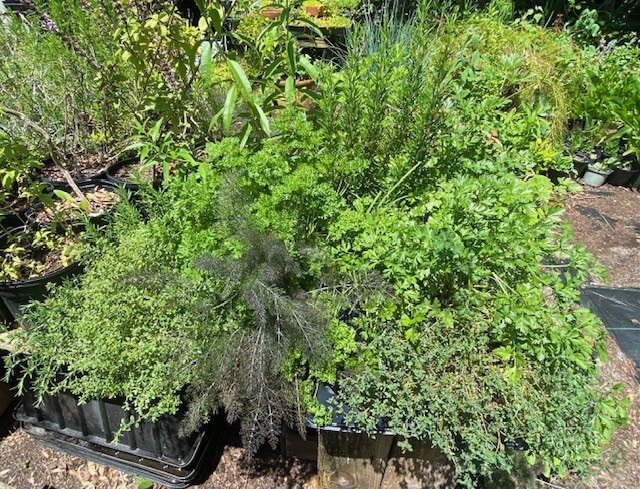
Most herbs are easy to grow in containers, too. These days, many gardeners have less space to garden or grow, but we can take advantage of growing in pots. Herbs can be planted together in a pot or planter (hanging baskets work too!) or underplanted. (I like to use variegated lemon thyme under a citrus tree in a large pot).
Sun to partial shade is the best to light to grow herbs. Most like well-drained soil, even in a container. Mint is often the exception — mint usually likes moist soil and doesn’t mind the shade.
If you are interested in learning more about growing and using herbs, please join us on Wed., May 14, at 10 AM. The Ho and Hum Garden Club will be hosting a presentation on herb gardening:
Herb Gardening May 14, at 10:00 AM
Hoe and Hum Garden Club St Francis Episcopal Church Gulf Breeze, Fla
Add some “spice” to your garden! Herbs can add beauty and interest, fragrance and flavor to your garden, and be useful as medicines or repellants. Herbs can be grown in ground or in containers. Join us to learn which herbs grow well in our area, and how to use them. We will discuss where, when and how to plant them.
And speaking of herbs — I found an eastern black swallowtail caterpillar yesterday on my fennel— the first of the season. We usually think of fennel as an herb with licorice flavor or fragrance, but fennel and other members of the carrot family (like parsley or dill) are “host” plants for the Eastern black swallowtail butterfly. That means that this beautiful black and blue butterfly lays its eggs on these plants, their caterpillars hatch from the egg, then begin to eat the plant.
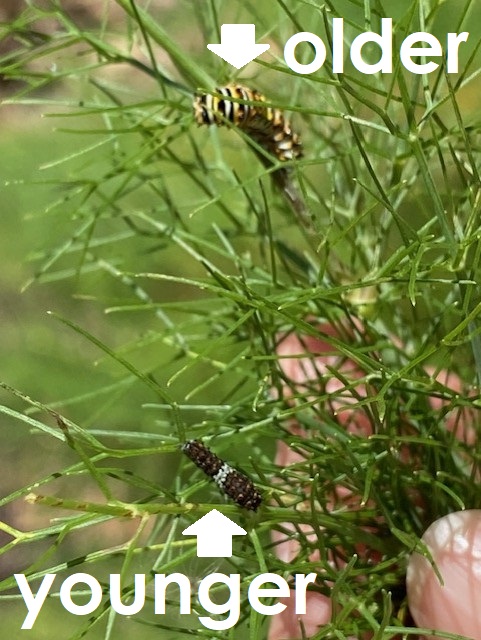
This caterpillar has amazing talents! When they hatch, they are a brownish color with a white splotch that looks remarkably like bird poop! This camouflage protects these butterfly babies as they grow — because who would want to eat bird poop?? This caterpillar molts four times, and each time the coloration changes. In the last two molts, the caterpillar has yellow, green, and black patterns that perfectly blend with the sunlight and shade on the plant. That makes these caterpillars hard to see on the plant (although children can spot them pretty quickly).
But camouflage is not their only defense. When swallowtail caterpillars are touched or sense danger, they react by rearing back, sending up two horn-like appendages, called osmeteria, that are bright orange or red. Osmeteria are glands (or organs) that look threatening. The osmeteria aren’t harmful but they emit a very stinky substance. If they were any larger, the smell would certainly make us back-off. All species of swallowtails have these defense mechanisms, but none of them sting or bite. In fact, none of our butterfly caterpillars will bite or sting, but some of our moth caterpillars can give painful stings. Caution before contact is the best advice.
How amazing that every species has the capacity to survive and continue through the seasons: defense mechanisms like camouflage or osmeteria to protect from predators; genetic adaptations like diapause, hibernation, or migration to survive seasonal changes of temperature and food sources; reproduction capabilities to continue the species.
The life process of butterflies from egg to adult is one of the most amazing sights in nature. The tiny cream-colored egg of the eastern black swallowtail is the size of the head of a pin. Depending on temperature, the egg will hatch in about a week. The tiny caterpillar — about an 1/8” long —will first eat the egg shell, then begin to eat the leaves of the host plant. Eating and molting for the next 10 days to a week (BTW, the caterpillars also eat the shedded skin after they molt), the caterpillar searches for a safe place to change into a chrysalis. After choosing the place, the caterpillar will attach itself there, using sticky silk. The swallowtails usually attach to a structure (a stem or leaf) catching hooks on their back legs in the silk. They add add an extra silk “rope” around the middle. Once secure, the process of change begins. The cells inside the caterpillar are changing as it pulsates and gyrates for several minutes. The old caterpillar skin will fall to the ground, and the chrysalis underneath is exposed. Swallowtail chrysalises are either green or brown, and resemble a leaf. In warm weather, the butterfly will hatch from the chrysalis in about a week. However, swallowtails that form the chrysalis in the fall are likely to stay in the chrysalis over the winter, hatching in the early spring. This process of suspended animation is called “diapause” and is similar to hibernation for mammals.
The seasons are changing in my vegetable garden. The cool weather plants are ready for harvest, and the veggies that grow in hot weather are being planted. I have been harvesting my potatoes — YUM! Nothing is quite so good as pulling a potato from the ground, immediately boiling it, then eating it. The taste is so different from a potato harvested days or weeks before. And just the fact that I can reach into the dirt and pull up a potato is amazing! If you have young children or grandchildren, be sure to plant some root crops next fall for spring harvest. Watching a child pull a radish, carrot, turnip, or potato from the ground is fun for everyone involved!
The yellow squash in the garden is really producing right now. These plants are in the cucurbit family, along with zucchini, pumpkins, melons, cucumbers, and gourds. Cucurbits have both male and female flowers. The female flowers are larger and also have the “baby” squash at the base. But this “baby” will not mature unless the flower is pollinated. The female flowers appear before the male flowers.
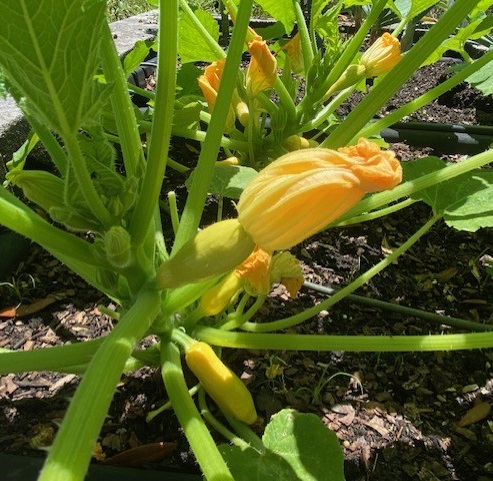
It sometimes appears that the plant is “sick” as the tiny squash wrinkle and wither. But actually, the flower hasn’t been pollinated – sometimes because the male flower has not yet appeared.
In recent years, many populations of our pollinating insects have declined. Loss of habitat and pesticide use can mean loss of squash for gardeners. There are too many flowers and not enough bees. Adding plants that attract pollinators throughout your garden (and particularly close to your cucurbits!) can help. Mostly, I see bumble bees in the squash flowers, so other plants that attract bumble bees (like the African blue basil) can be useful. I have observed that squash planted in raised beds or containers seem to have better pollination rates. I’m not sure why, but I wonder if that puts the flower on a more obvious level, where other flowers might be blooming.
I will say that I am seeing pollinators in greater number this year than in the past several years. Part of this is most likely a response to the extreme weather conditions, like snow in Pensacola! Over the almost eight years that I have lived in my current house, the number of pollinating insects has expanded remarkably. Many of the trees, shrubs, and perennials that I planted over the first several years are creating habitat for pollinators, predators, and “pest” insects; birds and squirrels; turtles and lizards; frogs and toads; plus one rat snake. Each species has a “job” in my ecosystem, and often the job is to keep a balance. The garden is full of birds this year too. They are eating insects, seeds, worms— because we can’t have one without the other. Without pest insects, their natural predators would not be present. I would rather just watch and let nature do the work.
My happiest bird news this month is that the Mississippi kites have returned to my neighborhood! Mississippi kites are gray birds about the size of a small hawk. Their flight patterns are very acrobatic — swooping and turning to great heights. They return every year to my neighborhood to nest and raise their young. I am very glad when I hear their beautiful call, and know that they have returned for another season. Their diet consists mainly of the larger insects: cicadas, dragonflies, large moths and beetles.
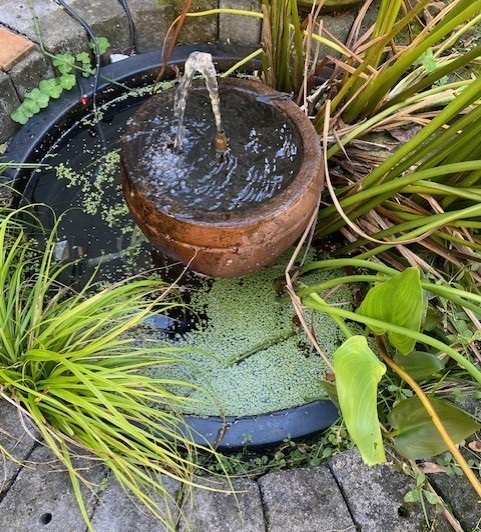
My small pond and fountain have attracted record numbers of birds in this dry weather. The indigo buntings seemed to arrive in small groups of 4-5 birds. The males are brilliant blue, the females are a light brown. The birds fly in to nearby vegetation to scout out the area. One by one, they take turns making their way from the plants to the pond or fountain to get a drink.
Providing water is essential in a habitat yard. Besides my small pond, I have three bird baths. All are well-used, but the pond is the favorite. The sound and movement of the water from the fountain brings birds year-round.
At The Garden Gate, there was a clematis planted on the fence. This vine would go dormant in the winter. As it was re-leafing in the spring, the young light green leaves would turn black. Zillions of aphids were covering the tender new leaves and sooty mildew was growing on aphid excrement. As an organic gardener, I would “intend” to use a soap spray to kill the aphids. But it was spring and I was a “busy” gardener — so I wouldn’t get to that chore. About a week later, I would look again to find the plant covered in ladybugs. All stages of ladybugs from larva (they looks like tiny black and red alligators), to adults were eating the aphids. This was natural “pest control”!
Meanwhile, chicks were hatching in the nearby sparrow nest. The adult sparrows were soon busy feeding the ladybugs to their chicks. I was quite upset! But I kept watching. Soon, the plant was pest-free, and there were still plenty of ladybugs around the garden. The sparrows had fledged and were operating as “pest control” all over the gardens. As the seasons changed, the clematis bloomed and was pollinated by many others insects. All of these species (and many more) play a part in the balance of the ecosystem. And I get to watch!

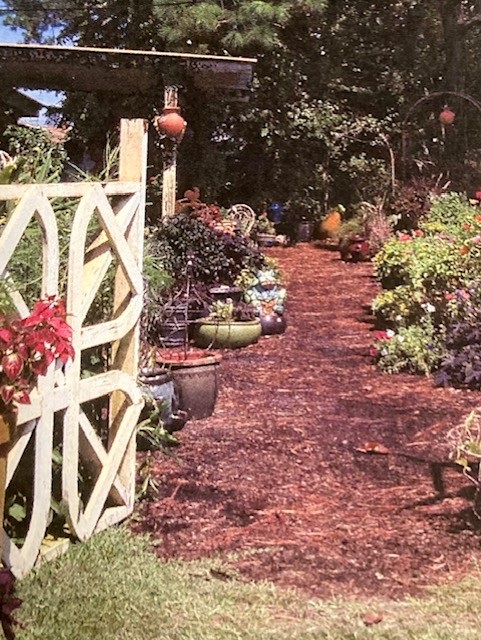
Leave a Reply to GardenDan Cancel reply